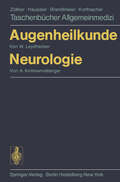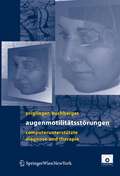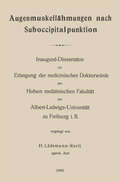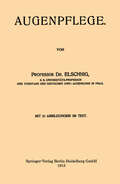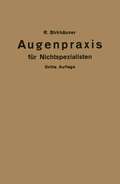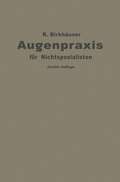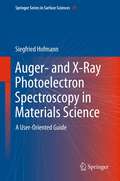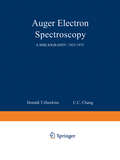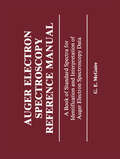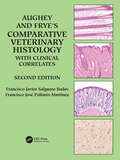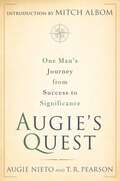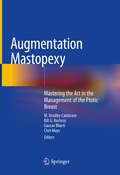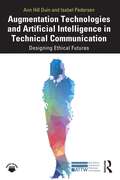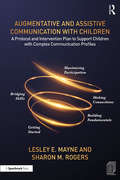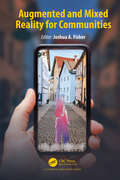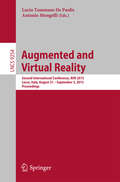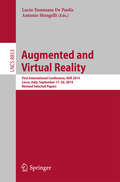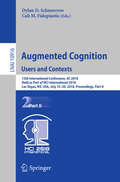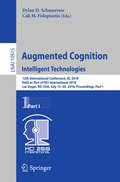- Table View
- List View
Augenheilkunde Neurologie (Taschenbücher Allgemeinmedizin)
by Wolfgang Leydhecker Annemarie KollmannsbergerAugenmotilitätsstörungen: Computerunterstütze Diagnose und Therapie
by Siegfried Priglinger Michael BuchbergerNeueste Erkenntnisse aus Biomechanik und Klinik ermöglichen eine computerunterstützte Darstellung der Augenmotilität von Schielen und komplexen Augenmotilitätsstörungen. Die biomechanischen Faktoren und die grundsätzlichen Operationsmethoden werden aufgezeigt. Die funktionelle Anatomie des Augenbewegungsapparates und dessen zentraler Steuerung, die anschauliche Beschreibung einfacher mathematischer Grundlagen der Okulomotorik und biomechanischer Augenmodelle, die Darstellung einer "funktionellen Topographie" als Orientierungshilfe für die Diagnostik und Simulation stehen im Mittelpunkt. An Beispielen werden parallel klinische und biomechanische Gesichtspunkte der Messung, Differentialdiagnostik und Simulation horizontaler und vertikaler Motilitätsstörungen besprochen. Ein interaktives Computerprogramm (SEE++) zur Simulation von Motilitätsstörungen sowie deren operativer Korrektur liegt als CD bei. Ein umfangreiches Literaturverzeichnis sowie zahlreiche Abbildungen und Tabellen vervollständigen das Buch.
Augenmuskellähmungen nach Suboccipitalpunktion: Inaugural-Dissertation
by Hermann Lüdemann-RavitDieser Buchtitel ist Teil des Digitalisierungsprojekts Springer Book Archives mit Publikationen, die seit den Anfängen des Verlags von 1842 erschienen sind. Der Verlag stellt mit diesem Archiv Quellen für die historische wie auch die disziplingeschichtliche Forschung zur Verfügung, die jeweils im historischen Kontext betrachtet werden müssen. Dieser Titel erschien in der Zeit vor 1945 und wird daher in seiner zeittypischen politisch-ideologischen Ausrichtung vom Verlag nicht beworben.
Augenpflege
by Anton ElschnigDieser Buchtitel ist Teil des Digitalisierungsprojekts Springer Book Archives mit Publikationen, die seit den Anfängen des Verlags von 1842 erschienen sind. Der Verlag stellt mit diesem Archiv Quellen für die historische wie auch die disziplingeschichtliche Forschung zur Verfügung, die jeweils im historischen Kontext betrachtet werden müssen. Dieser Titel erschien in der Zeit vor 1945 und wird daher in seiner zeittypischen politisch-ideologischen Ausrichtung vom Verlag nicht beworben.
Augenpraxis für Nichtspezialisten
by R. BirkhäuserDieser Buchtitel ist Teil des Digitalisierungsprojekts Springer Book Archives mit Publikationen, die seit den Anfängen des Verlags von 1842 erschienen sind. Der Verlag stellt mit diesem Archiv Quellen für die historische wie auch die disziplingeschichtliche Forschung zur Verfügung, die jeweils im historischen Kontext betrachtet werden müssen. Dieser Titel erschien in der Zeit vor 1945 und wird daher in seiner zeittypischen politisch-ideologischen Ausrichtung vom Verlag nicht beworben.
Augenpraxis für Nichtspezialisten
by Rudolf BirkhäuserDieser Buchtitel ist Teil des Digitalisierungsprojekts Springer Book Archives mit Publikationen, die seit den Anfängen des Verlags von 1842 erschienen sind. Der Verlag stellt mit diesem Archiv Quellen für die historische wie auch die disziplingeschichtliche Forschung zur Verfügung, die jeweils im historischen Kontext betrachtet werden müssen. Dieser Titel erschien in der Zeit vor 1945 und wird daher in seiner zeittypischen politisch-ideologischen Ausrichtung vom Verlag nicht beworben.
Augenzeugenschaft als Konzept: Konstruktionen von Wirklichkeit in Kunst und visueller Kultur seit 1800 (Image #146)
by Claudia Hattendorff Lisa BeißwangerWelche Rolle spielt Augenzeugenschaft in Kunst und visueller Kultur von ca. 1800 bis heute? Die Beiträge des Bandes untersuchen diese Frage an einem breiten Spektrum von Gegenständen: künstlerischen und nicht-künstlerischen Bildern, Aktionen und Installationen sowie Kunstinstitutionen und -literatur. Im Zentrum des Interesses steht, wie Effekte von Augenzeugenschaft hervorgerufen und Konstruktionen von Augenzeugenschaft bei der Produktion und Rezeption von Artefakten wirksam werden. Die Reihe der Beispiele ermöglicht erstmals einen vergleichenden und interdisziplinär anschlussfähigen Blick auf einen Diskurs und eine Praxis der Authentifizierung, die im 18. bis 21. Jahrhundert immer wieder von Belang gewesen sind.
Auger- and X-Ray Photoelectron Spectroscopy in Materials Science: A User-Oriented Guide (Springer Series in Surface Sciences #49)
by Siegfried HofmannTo anyone who is interested in surface chemical analysis of materials on the nanometer scale, this book is prepared to give appropriate information. Based on typical application examples in materials science, a concise approach to all aspects of quantitative analysis of surfaces and thin films with AES and XPS is provided. Starting from basic principles which are step by step developed into practically useful equations, extensive guidance is given to graduate students as well as to experienced researchers. Key chapters are those on quantitative surface analysis and on quantitative depth profiling, including recent developments in topics such as surface excitation parameter and backscattering correction factor. Basic relations are derived for emission and excitation angle dependencies in the analysis of bulk material and of fractional nano-layer structures, and for both smooth and rough surfaces. It is shown how to optimize the analytical strategy, signal-to-noise ratio, certainty and detection limit. Worked examples for quantification of alloys and of layer structures in practical cases (e.g. contamination, evaporation, segregation and oxidation) are used to critically review different approaches to quantification with respect to average matrix correction factors and matrix relative sensitivity factors. State-of-the-art issues in quantitative, destructive and non-destructive depth profiling are discussed with emphasis on sputter depth profiling and on angle resolved XPS and AES. Taking into account preferential sputtering and electron backscattering corrections, an introduction to the mixing-roughness-information depth (MRI) model and its extensions is presented.
Auger Electron Spectroscopy: A Bibliography: 1925–1975
by Donald T. HawkinsAuger electron spectroscopy is rapidly developing into the single most powerful analytical technique in basic and applied science.for investigating the chemical and structural properties of solids. Its ex plosive growth beginning in 1967 was triggered by the development of Auger analyzers capable of de tecting one atom layer of material in a fraction of a second. Continued growth was guaranteed firstly by the commercial availability of apparatus which combined the capabilities of scanning electron mi croscopy and ion-mill depth profiling with Auger analysis, and secondly by the increasing need to know the atomistics of many processes in fundamental research and engineering applications. The expanding use of Auger analysis was accompanied by an increase in the number of publications dealing with it. Because of the developing nature of Auger spectroscopy, the articles have appeared in many different sources covering diverse disciplines, so that it is extremely difficult to discover just what has or has not been subjected to Auger analysis. In this situation, a comprehensive bibliography is obviou-sly useful to those both inside and outside the field. For those in the field, this bibliography should be a wonderful time saver for locating certain references, in researching a particular topic, or when considering various aspects of instrumentation or data analysis. This bibliography not only provides the most complete listing of references pertinent to surface Auger analysis available today, but it is also a basis for extrapolating from past trends to future expectations.
Auger Electron Spectroscopy Reference Manual: A Book of Standard Spectra for Identification and Interpretation of Auger Electron Spectroscopy Data
by G. McGuireAuger electron spectroscopy (AES) is based on the Auger total secondary electron energy distribution, and an ion gun to process, which involves the core-level ionization of an atom with provide depth profiling capability. subsequent deexcitation occurring by an outer-level electron de The high surface sensitivity of Auger spectroscopy which dictates caying to fill the core hole. The excess energy is transferred to the need for an ultrahigh-vacuum system is due to the limited and causes the ejection of another electron, which is by definition mean free path of electrons in the 0-3000 e V kinetic energy an Auger electron. The Auger electron transition, denoted by range. The Auger peaks decay exponentially with overlayer cov the electron levels involved, is independent of the excitation erage, which is consistent with an exponential dependence of source and leaves the atom with a constant kinetic energy. The escape probability on the depth of the parent atom. A compila kinetic energy is given by the differences in binding energies for tion of data from a variety of sources has been used to generate the three levels (for example, EK-E L, - EL ) minus a correction 2 an escape depth curve which falls in the range of 5-30 A in the term for the work function and electron wave function relaxation. energy range from 0 to 3000 eV. The observed escape depth does When the Auger transition occurs within a few angstroms of the not show a strong dependence on the matrix.
Aughey and Frye’s Comparative Veterinary Histology with Clinical Correlates
by Francisco Javier Salguero Bodes Francisco Jose Pallares MartinezOrganised by body system, the new edition of this highly illustrated textbook covers the normal histological appearance of tissues in a wide range of animals, both domestic and exotic species, with relevant clinical correlates emphasising the need to appreciate the normal in order to recognise the abnormal. In this update by two experienced veterinary pathologists and histology lecturers, new species, such as other companion mammals, aquatic species, and livestock, are introduced into each chapter along with a wealth of new high-quality images. A new chapter covers epitehlial tissue, and new techniques used in histology and histopathology are discussed throughout, including in situ hybridisation (ISH) and digital image analysis. Pathogenesis explanations are introduced in the current (and many new) cases of histopathology. The breadth of coverage - farm animals, dogs, cats, horses, birds, reptiles, amphibians, and fish - and the integration of normal and abnormal tissue provide a reference of lasting value to veterinary students as well as veterinary practitioners and pathologists requiring a quick refresher.
Aughey and Frye’s Comparative Veterinary Histology with Clinical Correlates
by Francisco Javier Salguero Bodes Francisco Jose Pallares MartinezOrganised by body system, the new edition of this highly illustrated textbook covers the normal histological appearance of tissues in a wide range of animals, both domestic and exotic species, with relevant clinical correlates emphasising the need to appreciate the normal in order to recognise the abnormal. In this update by two experienced veterinary pathologists and histology lecturers, new species, such as other companion mammals, aquatic species, and livestock, are introduced into each chapter along with a wealth of new high-quality images. A new chapter covers epitehlial tissue, and new techniques used in histology and histopathology are discussed throughout, including in situ hybridisation (ISH) and digital image analysis. Pathogenesis explanations are introduced in the current (and many new) cases of histopathology. The breadth of coverage - farm animals, dogs, cats, horses, birds, reptiles, amphibians, and fish - and the integration of normal and abnormal tissue provide a reference of lasting value to veterinary students as well as veterinary practitioners and pathologists requiring a quick refresher.
Augie's Quest: One Man's Journey from Success to Significance
by T. R. Pearson Augie NietoWhat happens to "orphan" diseases that aren't big enough profit centers for the pharmaceutical industry or get caught in the web of government funding and academic research? Augie Nieto found out in the spring of 2005: At forty-seven years old he was diagnosed with ALS. Devastated, Augie struggled with depression and attempted suicide. When he awoke from a coma, with friends and family surrounding him, his sense of faith and mission were renewed. Fast-forward one year: Augie and his wife, Lynne, were profiled as "Real Heroes" on the Today show. Their determination to beat the disease had already led to major overhauls in the way ALS research was conducted. In partnership with the Muscular Dystrophy Association, Augie had set up a foundation and lab to coordinate and oversee ALS research and testing across the globe. By centralizing operations and championing an entrepreneurial approach to medical research, Augie and his team accomplished remarkable results in less than two years. Part inspiration, part business innovation, Augie's Quest illustrates how one person can make a meaningful difference. Praise for Augie Nieto: George H. W. Bush, former U.S. president: "Your contributions to the fitness industry are well known, and your dedication an inspiration." Lance Armstrong, seven-time "Le Tour de France" champion: "I think it says a lot about Augie, the fact that everybody came together regardless of whether or not it's for competing gyms or competing companies that make equipment. They all say, this is one of our own; this is a guy who's committed his life to our industry and has been dealt a serious blow. We're going to be there for him, we're going to say, we're here for you and we're part of the Quest." Arnold Schwarzenegger, governor of California: "Your success has been incredible. But you are so much more than just a successful businessman. You are the greatest husband, a great father, and a terrific friend. So,
Augmentation Mammaplasty E-Book: Redefining the Patient and Surgeon Experience
by John B. Tebbetts2010 PROSE Awards Honorable Mention, Clinical Medicine! John B. Tebbetts, MD, a pioneer in the field of breast augmentation, redefines the surgeon/patient experience in this comprehensive book. By exhaustively covering everything you need to know about breast augmentation, Dr. Tebbets allows for tightly focused guidance that is principle- rather than experienced-based, with numerous decision-making algorithms and outcome-based techniques, not just one-answer solutions. The book addresses topics that range from anesthesia and case studies of specific implants to practical matters like practice management. Focuses exclusively on breast augmentation to make coverage as comprehensive as possible. Includes much-needed information on practice management, including patient consent, systems analysis, marketing, and data acquisitions. Addresses pre-, intra-, and postoperative care of patient for guidance from start to finish. Utilizes a separate chapter for each approach to breast augmentation: inframammary, axillary, periaereolar, or umbilical. Incorporates case studies of specific implants to help you make the right decision for your patients. Details TEPID (Tissue characteristics of the Envelope and Parenchyma, the Implant, and Dimensions and filler dynamics of the implant) system: the first three-dimensional modeling system for quantitating tissue characteristics. Provides 15 decision-making algorithms for all aspects of implant selection, surgery, and complications----the only published resource to do so.
Augmentation Mastopexy: Mastering the Art in the Management of the Ptotic Breast
by M. Bradley Calobrace Bill G. Kortesis Gaurav Bharti Chet MaysBreast augmentation paired with mastopexy is often regarded as a challenging procedure since it is essentially two surgeries in one. Because of the complexity of the dual procedure, as well as the careful planning required, many doctors avoid performing these surgeries together, instead preferring their patient to undergo two separate surgeries.These two procedures can be safely performed with methodical planning and intra operative execution. This book provides not only insight and instruction on a variety of mastopexy procedures and accompanying types of breast augmentation, but it will also help the clinician determine the optimal surgery for each individual patient.Primarily meant for practicing aesthetic plastic surgeons, Augmentation Mastopexy -- Mastering the Art in the Management of the Ptotic Breast will also find use among plastic surgery fellows and plastic surgery residents. Unlike some of the competitive literature that briefly touches on the topic or simply provides an overview, the information provided is methodical and comprehensive, providing a wealth of color images to accompany the techniques described. Case studies with long-term follow up are also included, offering not only an understanding of potential pitfalls but a veritable how-to for handling complications when they do arise.
Augmentation Technologies and Artificial Intelligence in Technical Communication: Designing Ethical Futures (ATTW Series in Technical and Professional Communication)
by Ann Hill Duin Isabel PedersenThis book enables readers to interrogate the technical, rhetorical, theoretical, and socio-ethical challenges and opportunities involved in the development and adoption of augmentation technologies and artificial intelligence. The core of our human experience and identity is forever affected by the rise of augmentation technologies that enhance human capability or productivity. These technologies can add cognitive, physical, sensory, and emotional enhancements to the body or environment. This book demonstrates the benefits, risks, and relevance of emerging augmentation technologies such as brain–computer interaction devices for cognitive enhancement; robots marketed to improve human social interaction; wearables that extend human senses, augment creative abilities, or overcome physical limitations; implantables that amplify intelligence or memory; and devices, AI generators, or algorithms for emotional augmentation. It allows scholars and professionals to understand the impact of these technologies, improve digital and AI literacy, and practice new methods for their design and adoption. This book will be vital reading for students, scholars, and professionals in fields including technical communication, UX design, computer science, human factors, information technology, sociology of technology, and ethics. Artifacts and supplemental resources for research and teaching can be found at https://fabricofdigitallife.com and www.routledge.com/9781032263755.
Augmentation Technologies and Artificial Intelligence in Technical Communication: Designing Ethical Futures (ATTW Series in Technical and Professional Communication)
by Ann Hill Duin Isabel PedersenThis book enables readers to interrogate the technical, rhetorical, theoretical, and socio-ethical challenges and opportunities involved in the development and adoption of augmentation technologies and artificial intelligence. The core of our human experience and identity is forever affected by the rise of augmentation technologies that enhance human capability or productivity. These technologies can add cognitive, physical, sensory, and emotional enhancements to the body or environment. This book demonstrates the benefits, risks, and relevance of emerging augmentation technologies such as brain–computer interaction devices for cognitive enhancement; robots marketed to improve human social interaction; wearables that extend human senses, augment creative abilities, or overcome physical limitations; implantables that amplify intelligence or memory; and devices, AI generators, or algorithms for emotional augmentation. It allows scholars and professionals to understand the impact of these technologies, improve digital and AI literacy, and practice new methods for their design and adoption. This book will be vital reading for students, scholars, and professionals in fields including technical communication, UX design, computer science, human factors, information technology, sociology of technology, and ethics. Artifacts and supplemental resources for research and teaching can be found at https://fabricofdigitallife.com and www.routledge.com/9781032263755.
Augmentative and Assistive Communication with Children: A Protocol and Intervention Plan to Support Children with Complex Communication Profiles
by Lesley E. Mayne Sharon M. RogersThis practical resource is designed to help the families and professionals who support children who use augmentative and assistive communication (AAC) to interact with the world around them. The research-based Hear Me into Voice protocol, presented at the American Speech-Language-Hearing Association Annual Convention in 2018, the California Speech-Language Hearing Association Annual Convention in 2017, and the International Society for Augmentative and Alternative Communication Conference in 2016, provides communication partners with a functional knowledge of the child’s communication skills and provides a practical intervention plan to carry forward. Through this protocol and intervention plan, communication partners can engage with the child’s personal voice, through their varying multimodal forms of communication; the child is given the space to grow into a competent and confident communicator. Key features include: Photocopiable and downloadable resources, including the Hear Me into Voice protocol, an AAC report shell template, an AAC report teaching template, and tools including how to make a communication wallet, and a Let’s Chat communication partner tip card template. Guidance for offering AAC intervention sessions, including an intervention plan supported by case studies Practical activities that can be used to engage children with complex communication profiles Engaging and easy to follow, this resource is not only essential for professionals and students looking to support children with complex language needs, but also families looking to understand their child’s unique communication style.
Augmentative and Assistive Communication with Children: A Protocol and Intervention Plan to Support Children with Complex Communication Profiles
by Lesley E. Mayne Sharon M. RogersThis practical resource is designed to help the families and professionals who support children who use augmentative and assistive communication (AAC) to interact with the world around them. The research-based Hear Me into Voice protocol, presented at the American Speech-Language-Hearing Association Annual Convention in 2018, the California Speech-Language Hearing Association Annual Convention in 2017, and the International Society for Augmentative and Alternative Communication Conference in 2016, provides communication partners with a functional knowledge of the child’s communication skills and provides a practical intervention plan to carry forward. Through this protocol and intervention plan, communication partners can engage with the child’s personal voice, through their varying multimodal forms of communication; the child is given the space to grow into a competent and confident communicator. Key features include: Photocopiable and downloadable resources, including the Hear Me into Voice protocol, an AAC report shell template, an AAC report teaching template, and tools including how to make a communication wallet, and a Let’s Chat communication partner tip card template. Guidance for offering AAC intervention sessions, including an intervention plan supported by case studies Practical activities that can be used to engage children with complex communication profiles Engaging and easy to follow, this resource is not only essential for professionals and students looking to support children with complex language needs, but also families looking to understand their child’s unique communication style.
Augmented and Mixed Reality for Communities
by Joshua A. FisherUsing mixed and augmented reality in communities is an emerging media practice that is reshaping how we interact with our cities and neighbors. From the politics of city hall to crosswalks and playgrounds, mixed and augmented reality will offer a diverse range of new ways to interact with our communities. In 2016, apps for augmented reality politics began to appear in app stores. Similarly, the blockbuster success of Pokémon Go illustrated how even forgotten street corners can become a magical space for play. In 2019, a court case in Milwaukee, Wisconsin, extended first amendment rights to augmented reality. For all the good that these emerging media provide, there will and have been consequences. Augmented and Mixed Reality for Communities will help students and practitioners navigate the ethical design and development of these kinds of experiences to transform their cities. As one of the first books of its kind, each chapter in the book prepares readers to contribute to the Augmented City. By providing insight into how these emerging media work, the book seeks to democratize the augmented and mixed reality space.Authors within this volume represent some of the leading scholars and practitioners working in the augmented and mixed reality space for civic media, cultural heritage, civic games, ethical design, and social justice. Readers will find practical insights for the design and development to create their own compelling experiences. Teachers will find that the text provides in-depth, critical analyses for thought-provoking classroom discussions.
Augmented and Mixed Reality for Communities
by Joshua A. FisherUsing mixed and augmented reality in communities is an emerging media practice that is reshaping how we interact with our cities and neighbors. From the politics of city hall to crosswalks and playgrounds, mixed and augmented reality will offer a diverse range of new ways to interact with our communities. In 2016, apps for augmented reality politics began to appear in app stores. Similarly, the blockbuster success of Pokémon Go illustrated how even forgotten street corners can become a magical space for play. In 2019, a court case in Milwaukee, Wisconsin, extended first amendment rights to augmented reality. For all the good that these emerging media provide, there will and have been consequences. Augmented and Mixed Reality for Communities will help students and practitioners navigate the ethical design and development of these kinds of experiences to transform their cities. As one of the first books of its kind, each chapter in the book prepares readers to contribute to the Augmented City. By providing insight into how these emerging media work, the book seeks to democratize the augmented and mixed reality space.Authors within this volume represent some of the leading scholars and practitioners working in the augmented and mixed reality space for civic media, cultural heritage, civic games, ethical design, and social justice. Readers will find practical insights for the design and development to create their own compelling experiences. Teachers will find that the text provides in-depth, critical analyses for thought-provoking classroom discussions.
Augmented and Virtual Reality: Second International Conference, AVR 2015, Lecce, Italy, August 31 - September 3, 2015, Proceedings (Lecture Notes in Computer Science #9254)
by Lucio Tommaso De Paolis Antonio MongelliThis book constitutes the refereed proceedings of the Second International Conference on Augmented and Virtual Reality, AVR 2015, held in Lecce, Italy, in September 2015.The 32 papers and 8 short papers presented were carefully reviewed and selected from 82 submissions. The SALENTO AVR 2015 conference brings together a community of researchers from academia and industry, computer scientists, engineers, and physicians in order to share points of views, knowledge, experiences, and scientific and technical results related to state-of-the-art solutions and technologies on virtual and augmented reality applications for medicine, cultural heritage, education, industrial sectors, as well as the demonstration of advanced products and technologies.
Augmented and Virtual Reality: First International Conference, AVR 2014, Lecce, Italy, September 17-20, 2014, Revised Selected Papers (Lecture Notes in Computer Science #8853)
by Lucio Tommaso De Paolis Antonio MongelliThis book constitutes the thoroughly revised papers of the First International Conference on Augmented and Virtual Reality, AVR 2014, held in Lecce, Italy, in September 2014. The 28 papers, 2 tutorials and 3 keynotes presented were carefully reviewed and selected from 76 submissions. They include topics from virtual/augmented/mixed reality to 3D user interfaces and the technology needed to enable these environments to a wide range of applications (medical, entertainment, military, design, manufacture, maintenance, arts and cultural heritage).
Augmented Cognition: 12th International Conference, AC 2018, Held as Part of HCI International 2018, Las Vegas, NV, USA, July 15-20, 2018, Proceedings, Part II (Lecture Notes in Computer Science #10916)
by Dylan D. Schmorrow Cali M. FidopiastisThis two-volume set LNCS 10915 and 10916 constitutes the refereed proceedings of the 12h International Conference on Augmented Cognition, AC 2018, held as part of the 20th International Conference on Human-Computer Interaction, HCII 2018, in Las Vegas, NV, USA in July 2018. The 1171 papers presented at HCII 2018 conferences were carefully reviewed and selected from 4346 submissions. The papers cover the entire field of human-computer interaction, addressing major advances in knowledge and effective use of computers in a variety of applications areas. The papers in this volume are organized in the following topical sections:Cognitive modeling, perception, emotion and interaction, augmented learning and training, shared cognition, team performance and decision-making.
Augmented Cognition: 12th International Conference, AC 2018, Held as Part of HCI International 2018, Las Vegas, NV, USA, July 15-20, 2018, Proceedings, Part I (Lecture Notes in Computer Science #10915)
by Dylan D. Schmorrow Cali M. FidopiastisThis two-volume set LNCS 10915 and 10916 constitutes the refereed proceedings of the 12h International Conference on Augmented Cognition, AC 2018, held as part of the 20th International Conference on Human-Computer Interaction, HCII 2018, in Las Vegas, NV, USA in July 2018. The 1171 papers presented at HCII 2018 conferences were carefully reviewed and selected from 4346 submissions.The papers cover the entire field of human-computer interaction, addressing major advances in knowledge and effective use of computers in a variety of applications areas. The papers in this volume are organized in the following topical sections: context aware adaption strategies in augmented cognition, brain sensors and measures for operational environments, artificial intelligence and machine learning in augmented cognition, augmented cognition in virtual and mixed reality.
